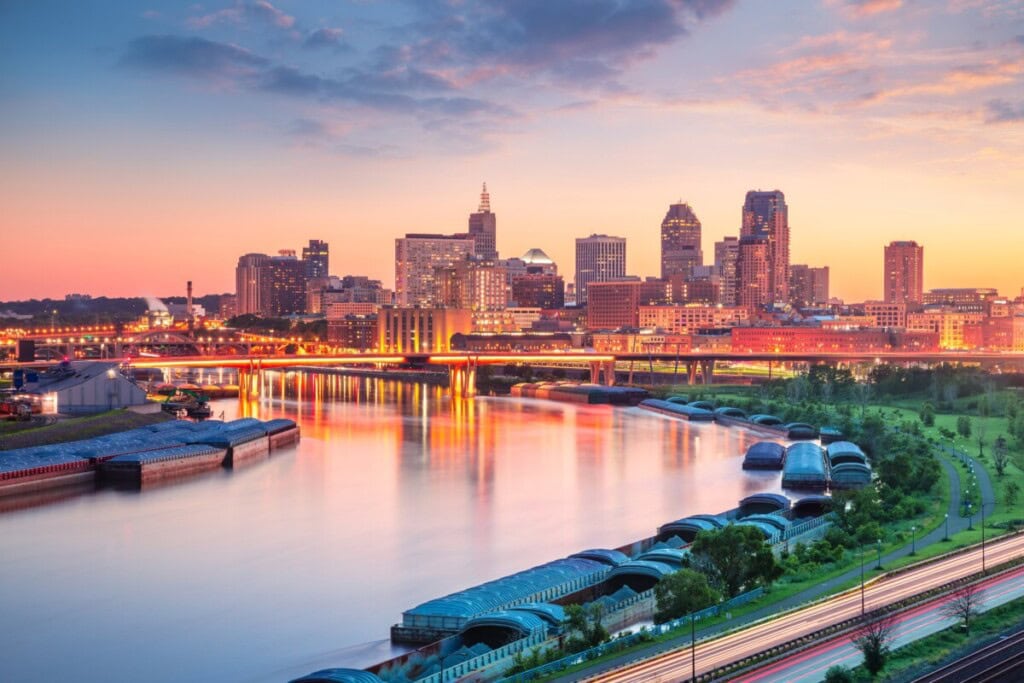Minneapolis vs Saint Paul: Which City is Right for You? Comparing Real Estate, Cost of Living, Culture, and More


When people think of the Twin Cities, they often wonder what makes owning a house in Minneapolis different from renting an apartment in Saint Paul. While these two cities may be close in geography, they are worlds apart in personality. Minneapolis offers a modern, energetic vibe with a thriving arts scene, while Saint Paul is steeped in history and known for its charming neighborhoods.
From housing costs and job markets to recreational opportunities and cultural experiences, each city has its own appeal. In this article, we’ll break down what sets Minneapolis and Saint Paul apart to help you determine which city best suits your needs.

Housing in Minneapolis vs Saint Paul
Minneapolis and Saint Paul offer two sides of the Twin Cities’ real estate market, with Minneapolis featuring modern urban housing and Saint Paul showcasing historic charm and affordability. Both cities provide a wide range of housing options, but their distinct personalities shine through their neighborhoods and living styles.
Housing in Minneapolis
Minneapolis caters to those seeking a vibrant urban lifestyle, with modern condos, downtown apartments, and renovated historic homes. Popular Minneapolis neighborhoods like North Loop and Uptown offer a mix of trendy living spaces and proximity to shopping, dining, and nightlife. The city is known for its walkability and bike-friendly streets, making it ideal for those who prefer city living.
- Median home cost: The median home sale price in Minneapolis is around $340,000, with diverse options in urban and suburban neighborhoods.
- Average rental cost: Apartments in Minneapolis rent for an average of $1,632 per month, with high-demand areas like Downtown Minneapolis commanding higher rates.

Housing in Saint Paul
Saint Paul offers a more traditional and affordable housing market, with charming bungalows, Victorian homes, and quiet tree-lined streets. Saint Paul’s neighborhoods like Highland Park and Summit Hill feature historic architecture and a community-oriented vibe. Saint Paul is ideal for those looking for a slower pace of life with easy access to parks and green spaces.
- Median home cost: The median home sale price in Saint Paul is approximately $287,298, providing more budget-friendly options compared to Minneapolis.
- Average rental cost: Renting an apartment in Saint Paul averages about $1,292 per month, making it a cost-effective choice for families and renters.

Cost of living in Minneapolis vs Saint Paul
Minneapolis’s cost of living compared to Saint Paul are roughly the same, but there are notable differences in housing, utilities, and lifestyle expenses. These distinctions reflect the unique characteristics of each city within the Twin Cities metro area.
1. Utilities
Utilities in Minneapolis are about 1% higher than in Saint Paul. Minneapolis’s larger population density and urban infrastructure drive up electricity and water costs, whereas Saint Paul’s smaller scale helps keep utility expenses slightly lower.
2. Groceries
Grocery prices in Minneapolis are about 2% lower than in Saint Paul. Minneapolis’s larger market and urban layout result in more competitive food costs, while Saint Paul’s smaller, community-focused grocery stores may have slightly higher prices.
3. Transportation
Transportation costs are roughly equal between Minneapolis and Saint Paul since both cities share the same public transit system. However, parking in downtown Minneapolis is generally more expensive than in Saint Paul, leading to slight variations for car owners.
4. Healthcare
Healthcare expenses in Minneapolis are the same as in Saint Paul. Both cities offer access to high-quality medical facilities, with costs balanced between larger centers in Minneapolis and community-oriented options in Saint Paul.
5. Lifestyle
Lifestyle expenses in Minneapolis are approximately 1% higher than in Saint Paul. Minneapolis’s dynamic arts and entertainment scene, as well as its trendy dining options, contribute to slightly elevated costs. Saint Paul, with its historic charm and more localized events, offers a slightly more affordable lifestyle.

Minneapolis vs Saint Paul in size and population
The Twin Cities of Minneapolis and Saint Paul are closely tied but offer different experiences based on their size and population. Minneapolis, the larger of the two, spans about 57 square miles and is home to nearly 430,000 residents, creating a more modern, fast-paced atmosphere with a denser urban core. Saint Paul, the state capital, covers 56 square miles and has a population of approximately 311,000, providing a quieter, more historic charm. The difference in population density allows Minneapolis to feel more vibrant and bustling, while Saint Paul exudes a more relaxed and community-focused energy.

Weather and climate in Minneapolis vs Saint Paul
Minneapolis’ climate and Saint Paul’s climate share the same continental climate, with cold, snowy winters and warm, humid summers. Winters in both cities are notoriously harsh, with temperatures often dropping below 0°F and significant snow accumulation. However, Minneapolis tends to feel slightly colder due to its more exposed urban landscape and wind tunnels created by downtown skyscrapers. Summers in both cities are comfortable, with average highs in the low 80s, though Saint Paul’s slightly smaller size and greenery can make it feel a bit less stifling. Severe weather, including thunderstorms and occasional tornadoes, affects both cities during the spring and summer months.

The job market in Minneapolis vs Saint Paul
Minneapolis: A hub for finance, healthcare, and tech
Minneapolis drives the Twin Cities’ economy with its strong focus on finance, healthcare, and a rapidly growing tech scene. Major companies like Target, U.S. Bancorp, and Medtronic are headquartered here, providing significant job opportunities. The city has an employment rate of 72% and a median household income of $81,000, with an average hourly wage of $33.80. Its thriving healthcare sector and innovative startups make it an attractive city for professionals in a range of industries, especially those looking for a vibrant urban setting with ample career growth potential.
Saint Paul: A center for government, education, and manufacturing
Saint Paul complements Minneapolis with a focus on government, education, and manufacturing. As Minnesota’s state capital, Saint Paul is home to numerous public-sector jobs, along with major institutions like the University of St. Thomas. Manufacturing also plays a key role, with companies like 3M driving employment in the region. The city’s employment rate stands at 68%, with a median household income of $74,000 and an average hourly wage of $33.80. Saint Paul’s diverse job market and community-oriented environment make it a great option for those seeking stability and work-life balance.

Transportation in Minneapolis vs Saint Paul
Minneapolis: Transit-friendly and bike-centric
Minneapolis features an expanding public transit network, including light rail and bus services provided by Metro Transit, making it a practical choice for commuters. The city is also highly regarded for its bike-friendly infrastructure, with an extensive network of bike lanes and trails that cater to both recreational and commuter cyclists. Walking is more common in densely populated neighborhoods like Downtown and Uptown, though the city’s cold winters can pose challenges.
- Walk Score: 71
- Bike Score: 83
- Transit Score: 55
Saint Paul: Car-friendly with growing transit options
Saint Paul’s transportation system is less transit-heavy than Minneapolis but still offers a reliable network of buses and shared light rail lines connecting the two cities. Driving is more common in Saint Paul, as the city’s quieter streets and ample parking make it easier to navigate by car. While biking is growing in popularity, it’s less integrated into the city’s infrastructure compared to Minneapolis. Walking is primarily convenient in central areas like Downtown and Summit Hill.
- Walk Score: 89
- Bike Score: 70

Travel in and out of Minneapolis vs Saint Paul
Both cities share access to major travel hubs, with Minneapolis serving as the primary center for air and rail connections, while Saint Paul provides additional travel options and scenic leisure opportunities.
- Minneapolis: Minneapolis-Saint Paul International Airport (MSP) serves as a major hub for domestic and international travel. Amtrak’s Empire Builder route connects Minneapolis to cities like Chicago and Seattle. Greyhound and Megabus offer regional and cross-country bus travel, while Metro Transit ensures local connectivity, including access to MSP Airport.
- Saint Paul: Saint Paul benefits from MSP Airport access and features Union Depot, a hub for Amtrak’s Empire Builder, Greyhound, and regional buses. Scenic riverboat cruises along the Mississippi River provide a unique way to travel or explore the area for leisure.

Lifestyle and things to do in Minneapolis vs Saint Paul
A day in the life of a Minneapolitan
Life in Minneapolis revolves around art, culture, and the outdoors. A typical day might start with a latte at a trendy café in the North Loop before heading to work in the bustling downtown area. Evenings are often spent exploring the city’s vibrant music scene or attending events at the Guthrie Theater. Weekends are perfect for cycling the city’s expansive trails, kayaking on Lake Harriet, or visiting the Minneapolis Sculpture Garden.
Top things to do in Minneapolis:
- Visit the Walker Art Center and Minneapolis Sculpture Garden
- See a performance at the Guthrie Theater
- Explore the Mill City Museum
- Attend a concert at First Avenue, a hub for live music
- Shop and dine at the Midtown Global Market
Google Street View of Midtown Global Market
Minneapolis parks and outdoor spaces:
- Walk or bike around the Chain of Lakes
- Paddleboard on Lake Calhoun (Bde Maka Ska)
- Explore Minnehaha Regional Park and its waterfall
- Cycle the Grand Rounds National Scenic Byway
- Picnic at Theodore Wirth Regional Park
Google Street View of Minnehaha Regional Park
Minneapolis tourist attractions:
- Stone Arch Bridge
- U.S. Bank Stadium tours
- Nicollet Mall for shopping and dining
- Target Field for a Minnesota Twins game
- Hennepin Avenue Theatre District
A day in the life of a Saint Paulite
Saint Paul offers a quieter, community-focused lifestyle with plenty of charm and history. Mornings might start with a coffee from a local café before heading to work or taking a stroll in Summit Avenue’s historic neighborhood. Evenings are perfect for dining at locally-owned restaurants or attending live performances at the Ordway Center for the Performing Arts. Weekends often involve exploring the Minnesota History Center or enjoying outdoor activities along the Mississippi River.
Top things to do in Saint Paul:
- Tour the Minnesota History Center
- Visit the Science Museum of Minnesota
- See a live performance at the Ordway Center for the Performing Arts
- Explore historic Summit Avenue and the James J. Hill House
- Cheer on the Minnesota Wild at the Xcel Energy Center
Google Street View of the James J. Hill House
Saint Paul parks and outdoor spaces:
- Walk or bike along the Mississippi River Trail
- Explore Como Park Zoo and Conservatory
- Kayak on the Mississippi River
- Attend seasonal events at Rice Park
- Hike through Battle Creek Regional Park
Google Street View of the Mississippi River Trail
Saint Paul tourist attractions:
- Landmark Center
- Cathedral of Saint Paul
- Wabasha Street Caves tours
- Allianz Field for soccer games
- Harriet Island Regional Park
Food and culture in Minneapolis vs Saint Paul
Minneapolis: A foodie’s paradise with a modern arts edge
Minneapolis is a culinary destination celebrated for its innovative food scene and farm-to-table ethos. Known for iconic dishes like the Juicy Lucy, the city also excels in diverse offerings, with vibrant Southeast Asian, Scandinavian, and African cuisines available throughout neighborhoods like Uptown and Northeast. Breweries and craft distilleries are central to the city’s culture, providing locals with unique spots to gather. On the cultural side, Minneapolis shines with institutions like the Guthrie Theater and Walker Art Center, while events like the Minnesota Fringe Festival highlight the city’s creative spirit.
Saint Paul: A historic yet eclectic culinary and cultural gem
Saint Paul’s food scene is steeped in tradition while embracing new flavors. Known for its historic eateries and cozy neighborhood restaurants, the city is famous for its hearty fare, including walleye and wild rice dishes, as well as classic bakeries and delis. Growing culinary innovation is evident in the West Seventh and Lowertown areas, which feature eclectic dining options and craft breweries. Saint Paul’s cultural scene reflects its rich history, with landmarks like the Cathedral of Saint Paul and the Minnesota History Center. Festivals such as the Winter Carnival and European Christmas Market bring the community together, blending food, arts, and heritage.

The post Minneapolis vs Saint Paul: Which City is Right for You? Comparing Real Estate, Cost of Living, Culture, and More appeared first on Redfin | Real Estate Tips for Home Buying, Selling & More.



